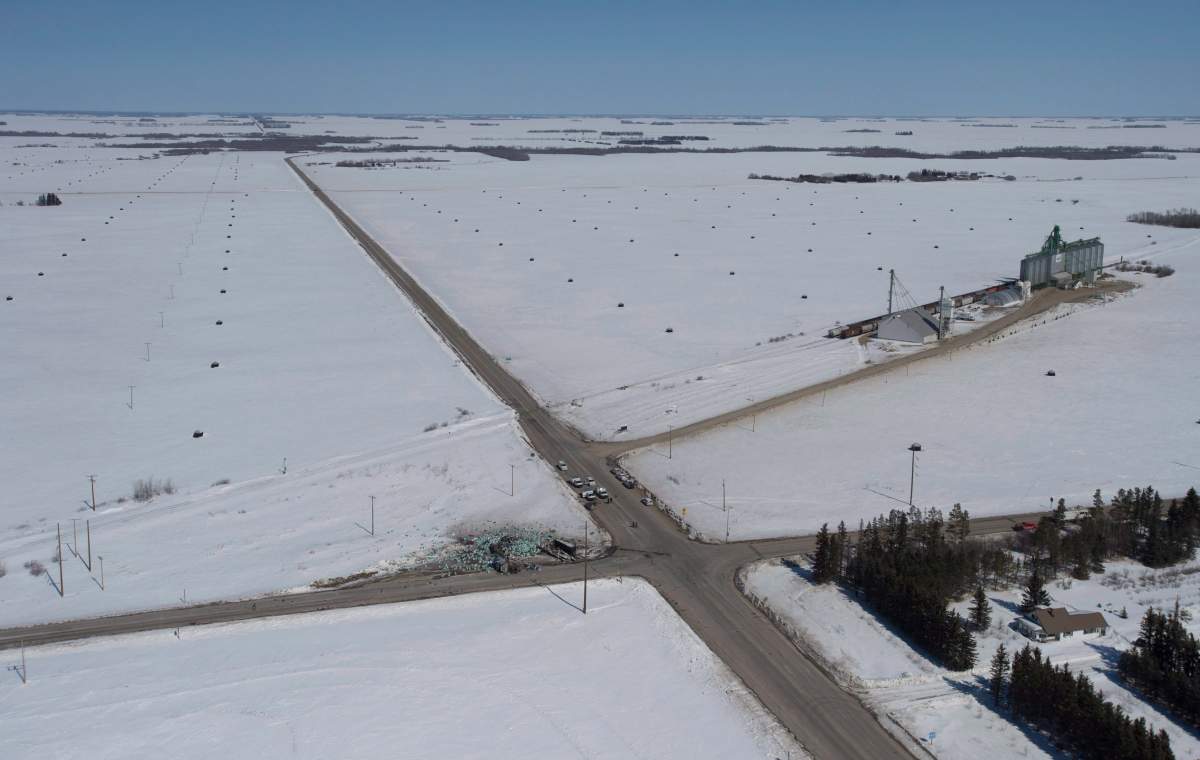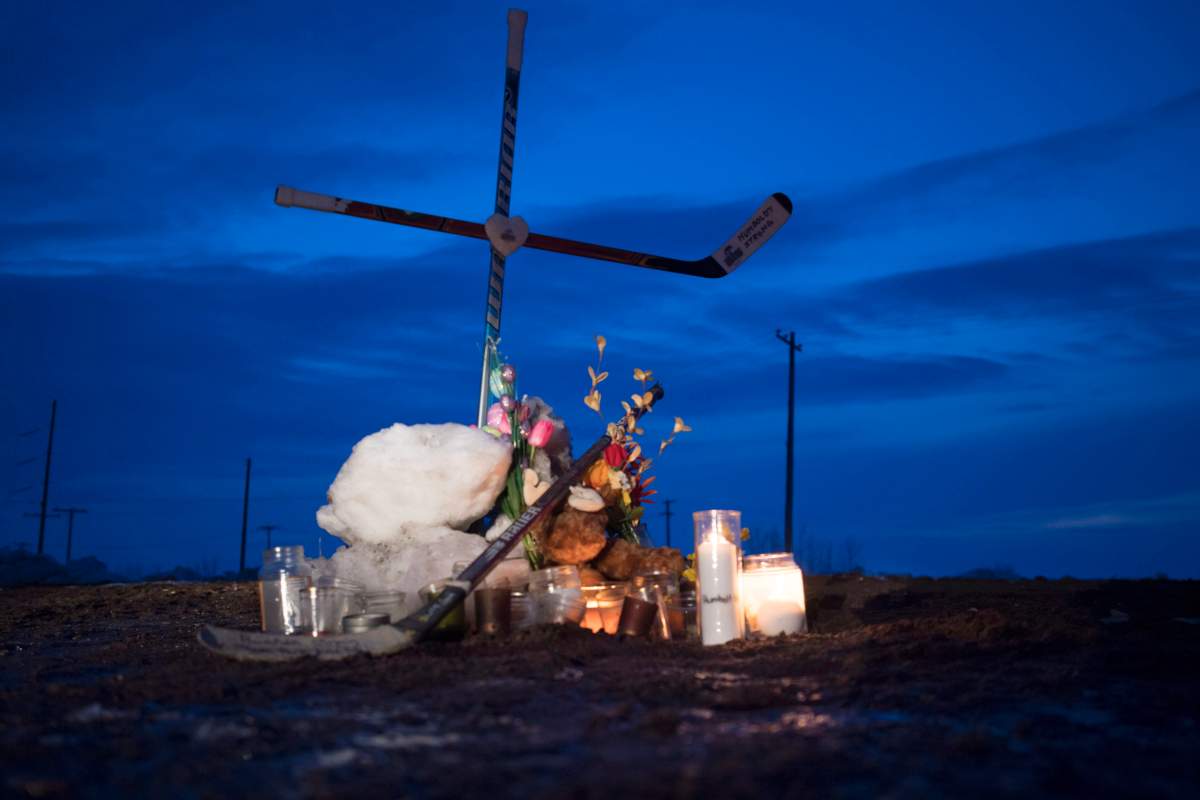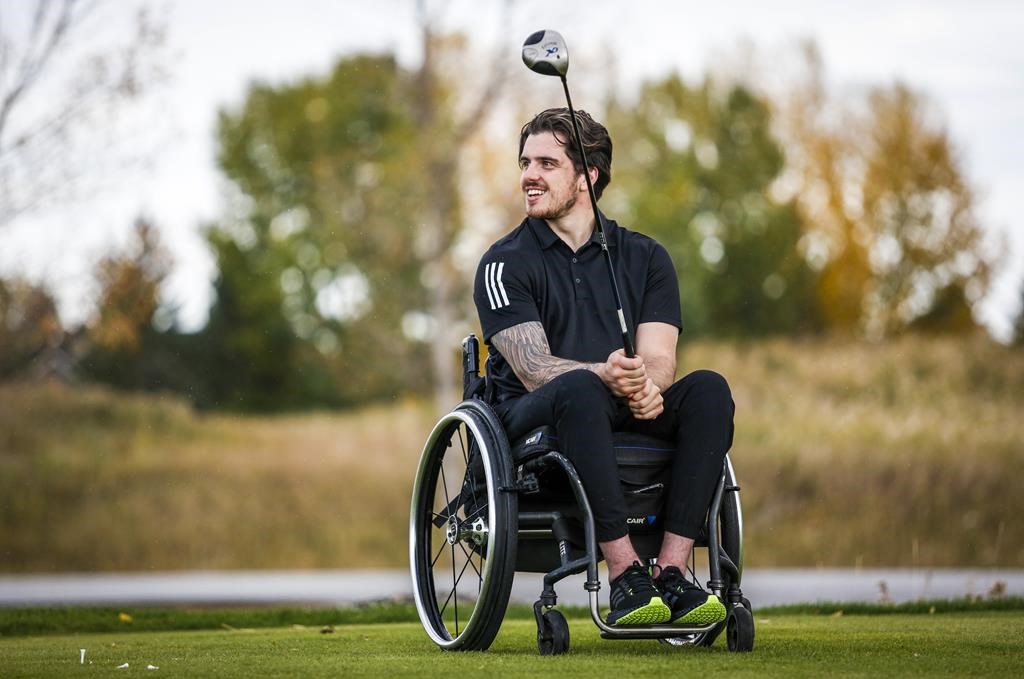This article has been updated to correct an earlier mistake. The crash took place during the week-long Easter school break, not over the long weekend.

You likely remember where you were when you heard about the Humboldt Broncos bus crash.
It was an event that froze Canadians.
On April 6, 2018, a semi-truck sped through a stop sign in rural Saskatchewan and hit the bus carrying the junior hockey team.
In total, 16 people died and 13 people were seriously injured.
Immediately afterward, many Canadians and people around the world reached out to the families, sending things such as notes and quilts and signed banners.
In the five years since, Canadians donned jerseys to demonstrate solidarity with the team and affected families, or green shirts to show support for organ donations.
Many watched the funerals and, perhaps, kept up to date on the trial of the man who drove the truck.
But a survivor and families who spoke to Global News said they’re still grieving. And they said it doesn’t feel like the crash was five years ago.
“It seems like time has flown by way faster,” Ryan Straschnitzki said.
Straschnitzki, a former Bronco, was paralyzed from the chest down in the crash. Since then he’s undergone experimental spine surgery, enabling him to take a few steps. He started playing sledge hockey, earning a spot Alberta’s provincial team. He’s hoping to play for Canada.
But he said he’s still dealing with the crash and the loss of his teammates.
“I’ve definitely had those moments where I let grief take over my day and ruin it for myself and I guess the people around me,” he said.
He said he battles it back, but it’s never easy.
“Sometimes it takes a couple of minutes, sometimes it takes a couple hours, it all depends.”

Toby and Bernadine Boulet’s son Logan was also a Bronco. He didn’t survive his injuries.
“It’s hard some days,” Toby said.
“Some days are just — you just go through your day and all of a sudden it’s five years.”
“The fact that people keep saying, ‘it’s the fifth year anniversary,’ it’s that milestone kind of time that makes those things kind of hard,” Bernadine added.
Carol Brons, whose daughter Dayna Brons was the team’s athletic therapist, said the grief is never really gone.
“You learn… how to control it a little bit more, but you never truly know when it’s going to hit you,” she said.
“Sometimes the sea is calm. The next day there’s a storm and you get hit by the wave.”
None of them said they’ve made sense of what happened. They only said they keep pushing forward, trying to honour their loved ones and teammates while learning to live new lives.
April 6, 2018
Carol slept in on the day of the crash. She works at a school and it was the Friday of the week-long Easter break. The Broncos were heading to Nipawin, about two hours north, for a playoff game.

Get breaking National news
“I didn’t get up to say goodbye,” she said. “I heard (Dayna) leave. I didn’t think anything of it.”
She said they usually didn’t go to away games.
She first learned of the crash when a coworker texted her.
“I read the message out loud and my husband said, ‘Well, maybe they had a flat tire or they got hit by a deer or something.’”
They decided to drive up to where the crash had taken place, about 20 minutes south of Nipawin.
Straschnitzki told Global News he remembers it clearly.
“I heard a scream from the front of the bus,” Straschnitzki said.
“The bus driver had both hands on the wheel and he was looking to his right. And I looked and instantly a semi-truck was coming our way.”
Then everything went black.
When he regained consciousness, he said, his back was against the semi. He was looking down and trying to figure out what happened.
His first instinct, he remembers, was to move.
He couldn’t. He thought he was stuck.
“I remember looking down on my legs and not seeing anything there,” he said.
“I knew something was wrong.”
He tried to call for help but his injuries were too severe. He waited until bystanders, and then first responders arrived to take him to hospital.
The Boulets came across the scene by accident. They were driving up to Nipawin, having left not long after the team bus.
They wanted to be there for what they believed to be Logan’s last game as a junior hockey player. He had enrolled at the University of Lethbridge and wanted to be a teacher.
As they approached the intersection of Highway 35 and 335, they saw vehicles ahead of them had stopped.
“Logan’s billet brother was sitting in the front of our vehicle with Toby, and he said, ‘That’s a Bronco hockey bag in the middle of the road,’” Bernadine told Global News.
“The thoughts going through our head was like, ‘Holy cow, this is like, that means that that’s Logan,’” she said.
“And the bus was on its side. It was laying on its side.”
Toby continues the story, saying he got out of his truck. He and others began placing blankets on bodies.
“There’s people that were holding bodies of people that kids that were still alive, young men are still alive.”
He said he approached the bus where he saw a foot in the window. The foot started to move so Toby yelled for help.
By then first responders had arrived. Toby said they used the jaws of life to remove the person who was still alive.
Toby said first responders told him three times they needed to leave the site.
They reconvened at a church in Nipawin with other families.
They learned Logan had been taken for treatment to Saskatoon, nearly 250 km away. They left quickly to be by his side.

Carol didn’t know what exactly had happened to Dayna. She started calling hospitals, realizing she could probably learn where Dayna was since she was the only woman on the bus.
She briefly saw Dayna in hospital in nearby Tisdale, Sask., before she was also taken to Saskatoon.
The Boulets and Carol said those days in hospital were hell.
“It’s just that room that you see on TV in terms of shows and you don’t ever want to be there,” Tobey said.
Toby and Bernadine said they didn’t realize how dire Logan’s situation was. They thought, at the time, he could recover and become a Paralympian.
“We knew there was a spinal injury,” Bernadine said.
“We didn’t know about the brain stem injury.
“We (were) fortunate enough to spend about 27 hours with Logan in the hospital… we sang songs, we read stories to him… we joked, we laughed, we cried, we all did that.”
Eventually, a nurse came in to ask about donating Logan’s organs.
Logan had previously said he wanted to be a donor, so they agreed.
“After we walked Logan to the operating room, we left the hospital. And as we were walking down the hallway, there was a man coming with a cart with coolers. And you knew that the coolers where they were going and what they’re being used for.”
Logan died on April 7, 2018.
His organs went to help six people and April 7 is now known as Green Shirt Day, raising awareness for organ donations.
And in a phenomenon now known as the “Logan Boulet effect,” hundreds of thousands of Canadians have registered to become organ donors.
Dayna died on April 11, 2018.
Carol has become an advocate for road safety. She’s now a director of Safer Roads Canada and pushes for stricter truck driver training and regulations.
“We need to make some kind of change so other people don’t have to hopefully go through anything similar,” she said.
Five years later
Carol and the Boulets said they’ll mark April 6 quietly.
They said they hope Canadians remember the first responders who helped and the Broncos who were injured and who died.
Carol said she hopes people across the country use the day to remember other people they’ve lost. “Take time to remember other people in your lives that you’ve lost.”
Toby and Bernadine ask everyone put a hockey stick outside their doors, like in the days after the crash.
“We just thank people for remembering and thinking of the Broncos and thank them for the support they gave us because we are all trying to give back as hard as we can,” Toby said.
Straschnitzki told Global News he would also pass the day quietly. He said it was emotional but he would focus on checking in with his teammates and their families.
He said the crash was a part of his life but that he won’t be defined by it.
He recently met with accessibility advocate Rick Hansen and has started focusing on making buildings more accessible.
Having been in a wheelchair for five years, he said, has made him realize how important equal access is.
“We can’t control a lot of the things that happen to us,” he said.
“We can only control what happens after.”
— with files from Quinn Campbell, Global news and Bill Graveland, The Canadian Press











Comments